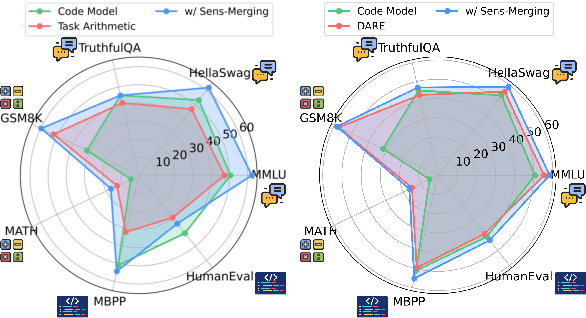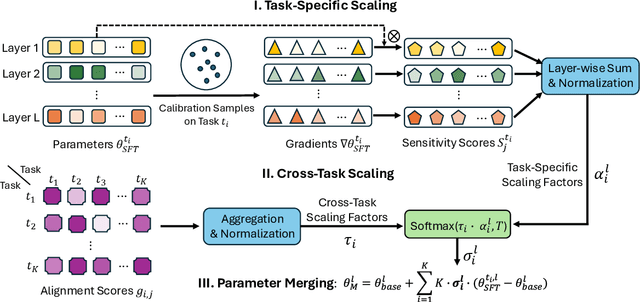Bowei He
Counterfactual Multi-player Bandits for Explainable Recommendation Diversification
May 27, 2025Abstract:Existing recommender systems tend to prioritize items closely aligned with users' historical interactions, inevitably trapping users in the dilemma of ``filter bubble''. Recent efforts are dedicated to improving the diversity of recommendations. However, they mainly suffer from two major issues: 1) a lack of explainability, making it difficult for the system designers to understand how diverse recommendations are generated, and 2) limitations to specific metrics, with difficulty in enhancing non-differentiable diversity metrics. To this end, we propose a \textbf{C}ounterfactual \textbf{M}ulti-player \textbf{B}andits (CMB) method to deliver explainable recommendation diversification across a wide range of diversity metrics. Leveraging a counterfactual framework, our method identifies the factors influencing diversity outcomes. Meanwhile, we adopt the multi-player bandits to optimize the counterfactual optimization objective, making it adaptable to both differentiable and non-differentiable diversity metrics. Extensive experiments conducted on three real-world datasets demonstrate the applicability, effectiveness, and explainability of the proposed CMB.
A Survey on Side Information-driven Session-based Recommendation: From a Data-centric Perspective
May 18, 2025Abstract:Session-based recommendation is gaining increasing attention due to its practical value in predicting the intents of anonymous users based on limited behaviors. Emerging efforts incorporate various side information to alleviate inherent data scarcity issues in this task, leading to impressive performance improvements. The core of side information-driven session-based recommendation is the discovery and utilization of diverse data. In this survey, we provide a comprehensive review of this task from a data-centric perspective. Specifically, this survey commences with a clear formulation of the task. This is followed by a detailed exploration of various benchmarks rich in side information that are pivotal for advancing research in this field. Afterwards, we delve into how different types of side information enhance the task, underscoring data characteristics and utility. Moreover, we discuss the usage of various side information, including data encoding, data injection, and involved techniques. A systematic review of research progress is then presented, with the taxonomy by the types of side information. Finally, we summarize the current limitations and present the future prospects of this vibrant topic.
Semantic Retrieval Augmented Contrastive Learning for Sequential Recommendation
Mar 06, 2025Abstract:Sequential recommendation aims to model user preferences based on historical behavior sequences, which is crucial for various online platforms. Data sparsity remains a significant challenge in this area as most users have limited interactions and many items receive little attention. To mitigate this issue, contrastive learning has been widely adopted. By constructing positive sample pairs from the data itself and maximizing their agreement in the embedding space,it can leverage available data more effectively. Constructing reasonable positive sample pairs is crucial for the success of contrastive learning. However, current approaches struggle to generate reliable positive pairs as they either rely on representations learned from inherently sparse collaborative signals or use random perturbations which introduce significant uncertainty. To address these limitations, we propose a novel approach named Semantic Retrieval Augmented Contrastive Learning (SRA-CL), which leverages semantic information to improve the reliability of contrastive samples. SRA-CL comprises two main components: (1) Cross-Sequence Contrastive Learning via User Semantic Retrieval, which utilizes large language models (LLMs) to understand diverse user preferences and retrieve semantically similar users to form reliable positive samples through a learnable sample synthesis method; and (2) Intra-Sequence Contrastive Learning via Item Semantic Retrieval, which employs LLMs to comprehend items and retrieve similar items to perform semantic-based item substitution, thereby creating semantically consistent augmented views for contrastive learning. SRA-CL is plug-and-play and can be integrated into standard sequential recommendation models. Extensive experiments on four public datasets demonstrate the effectiveness and generalizability of the proposed approach.
Sens-Merging: Sensitivity-Guided Parameter Balancing for Merging Large Language Models
Feb 19, 2025



Abstract:Recent advances in large language models have led to numerous task-specialized fine-tuned variants, creating a need for efficient model merging techniques that preserve specialized capabilities while avoiding costly retraining. While existing task vector-based merging methods show promise, they typically apply uniform coefficients across all parameters, overlooking varying parameter importance both within and across tasks. We present Sens-Merging, a sensitivity-guided coefficient adjustment method that enhances existing model merging techniques by operating at both task-specific and cross-task levels. Our method analyzes parameter sensitivity within individual tasks and evaluates cross-task transferability to determine optimal merging coefficients. Extensive experiments on Mistral 7B and LLaMA2-7B/13B models demonstrate that Sens-Merging significantly improves performance across general knowledge, mathematical reasoning, and code generation tasks. Notably, when combined with existing merging techniques, our method enables merged models to outperform specialized fine-tuned models, particularly in code generation tasks. Our findings reveal important trade-offs between task-specific and cross-task scalings, providing insights for future model merging strategies.
PASER: Post-Training Data Selection for Efficient Pruned Large Language Model Recovery
Feb 18, 2025Abstract:Model pruning is an effective approach for compressing large language models. However, this process often leads to significant degradation of model capabilities. While post-training techniques such as instruction tuning are commonly employed to recover model performance, existing methods often overlook the uneven deterioration of model capabilities and incur high computational costs. Moreover, some instruction data irrelevant to model capability recovery may introduce negative effects. To address these challenges, we propose the \textbf{P}ost-training d\textbf{A}ta \textbf{S}election method for \textbf{E}fficient pruned large language model \textbf{R}ecovery (\textbf{PASER}). PASER aims to identify instructions where model capabilities are most severely compromised within a certain recovery data budget. Our approach first applies manifold learning and spectral clustering to group recovery data in the semantic space, revealing capability-specific instruction sets. We then adaptively allocate the data budget to different clusters based on the degrees of model capability degradation. In each cluster, we prioritize data samples where model performance has declined dramatically. To mitigate potential negative transfer, we also detect and filter out conflicting or irrelevant recovery data. Extensive experiments demonstrate that PASER significantly outperforms conventional baselines, effectively recovering the general capabilities of pruned LLMs while utilizing merely 4\%-20\% of the original post-training data.
Beyond Models! Explainable Data Valuation and Metric Adaption for Recommendation
Feb 12, 2025Abstract:User behavior records serve as the foundation for recommender systems. While the behavior data exhibits ease of acquisition, it often suffers from varying quality. Current methods employ data valuation to discern high-quality data from low-quality data. However, they tend to employ black-box design, lacking transparency and interpretability. Besides, they are typically tailored to specific evaluation metrics, leading to limited generality across various tasks. To overcome these issues, we propose an explainable and versatile framework DVR which can enhance the efficiency of data utilization tailored to any requirements of the model architectures and evaluation metrics. For explainable data valuation, a data valuator is presented to evaluate the data quality via calculating its Shapley value from the game-theoretic perspective, ensuring robust mathematical properties and reliability. In order to accommodate various evaluation metrics, including differentiable and non-differentiable ones, a metric adapter is devised based on reinforcement learning, where a metric is treated as the reinforcement reward that guides model optimization. Extensive experiments conducted on various benchmarks verify that our framework can improve the performance of current recommendation algorithms on various metrics including ranking accuracy, diversity, and fairness. Specifically, our framework achieves up to 34.7\% improvements over existing methods in terms of representative NDCG metric. The code is available at https://github.com/renqii/DVR.
Certifying Language Model Robustness with Fuzzed Randomized Smoothing: An Efficient Defense Against Backdoor Attacks
Feb 09, 2025Abstract:The widespread deployment of pre-trained language models (PLMs) has exposed them to textual backdoor attacks, particularly those planted during the pre-training stage. These attacks pose significant risks to high-reliability applications, as they can stealthily affect multiple downstream tasks. While certifying robustness against such threats is crucial, existing defenses struggle with the high-dimensional, interdependent nature of textual data and the lack of access to original poisoned pre-training data. To address these challenges, we introduce \textbf{F}uzzed \textbf{R}andomized \textbf{S}moothing (\textbf{FRS}), a novel approach for efficiently certifying language model robustness against backdoor attacks. FRS integrates software robustness certification techniques with biphased model parameter smoothing, employing Monte Carlo tree search for proactive fuzzing to identify vulnerable textual segments within the Damerau-Levenshtein space. This allows for targeted and efficient text randomization, while eliminating the need for access to poisoned training data during model smoothing. Our theoretical analysis demonstrates that FRS achieves a broader certified robustness radius compared to existing methods. Extensive experiments across various datasets, model configurations, and attack strategies validate FRS's superiority in terms of defense efficiency, accuracy, and robustness.
NILE: Internal Consistency Alignment in Large Language Models
Dec 21, 2024Abstract:As a crucial step to enhance LLMs alignment with human intentions, Instruction Fine-Tuning (IFT) has a high demand on dataset quality. However, existing IFT datasets often contain knowledge that is inconsistent with LLMs' internal knowledge learned from the pre-training phase, which can greatly affect the efficacy of IFT. To address this issue, we introduce NILE (iNternal consIstency aLignmEnt) framework, aimed at optimizing IFT datasets to unlock LLMs' capability further. NILE operates by eliciting target pre-trained LLM's internal knowledge corresponding to instruction data. The internal knowledge is leveraged to revise the answer in IFT datasets. Additionally, we propose a novel Internal Consistency Filtering (ICF) method to filter training samples, ensuring its high consistency with LLM's internal knowledge. Our experiments demonstrate that NILE-aligned IFT datasets sharply boost LLM performance across multiple LLM ability evaluation datasets, achieving up to 66.6% gain on Arena-Hard and 68.5% on Alpaca-Eval V2. Further analysis confirms that each component of the NILE}framework contributes to these substantial performance improvements, and provides compelling evidence that dataset consistency with pre-trained internal knowledge is pivotal for maximizing LLM potential.
Interpretable Triplet Importance for Personalized Ranking
Jul 28, 2024



Abstract:Personalized item ranking has been a crucial component contributing to the performance of recommender systems. As a representative approach, pairwise ranking directly optimizes the ranking with user implicit feedback by constructing (\textit{user}, \textit{positive item}, \textit{negative item}) triplets. Several recent works have noticed that treating all triplets equally may hardly achieve the best effects. They assign different importance scores to negative items, user-item pairs, or triplets, respectively. However, almost all the generated importance scores are groundless and hard to interpret, thus far from trustworthy and transparent. To tackle these, we propose the \textit{Triplet Shapley} -- a Shapely value-based method to measure the triplet importance in an interpretable manner. Due to the huge number of triplets, we transform the original Shapley value calculation to the Monte Carlo (MC) approximation, where the guarantee for the approximation unbiasedness is also provided. To stabilize the MC approximation, we adopt a control covariates-based method. Finally, we utilize the triplet Shapley value to guide the resampling of important triplets for benefiting the model learning. Extensive experiments are conducted on six public datasets involving classical matrix factorization- and graph neural network-based recommendation models. Empirical results and subsequent analysis show that our model consistently outperforms the state-of-the-art methods.
Mitigating Large Language Model Hallucination with Faithful Finetuning
Jun 17, 2024



Abstract:Large language models (LLMs) have demonstrated remarkable performance on various natural language processing tasks. However, they are prone to generating fluent yet untruthful responses, known as "hallucinations". Hallucinations can lead to the spread of misinformation and cause harm in critical applications. Mitigating hallucinations is challenging as they arise from factors such as noisy data, model overconfidence, lack of knowledge, and the generation process itself. Recent efforts have attempted to address this issue through representation editing and decoding algorithms, reducing hallucinations without major structural changes or retraining. However, these approaches either implicitly edit LLMs' behavior in latent space or suppress the tendency to output unfaithful results during decoding instead of explicitly modeling on hallucination. In this work, we introduce Faithful Finetuning (F2), a novel method that explicitly models the process of faithful question answering through carefully designed loss functions during fine-tuning. We conduct extensive experiments on popular datasets and demonstrate that F2 achieves significant improvements over vanilla models and baselines.
 Add to Chrome
Add to Chrome Add to Firefox
Add to Firefox Add to Edge
Add to Edge